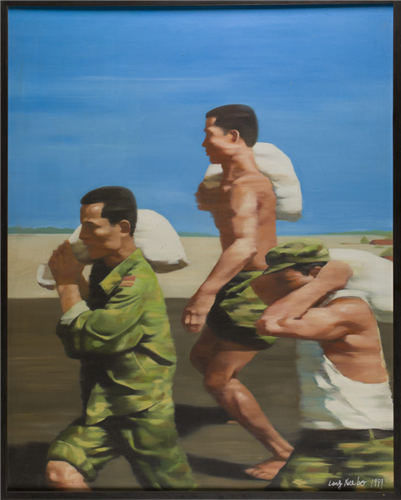 |
|
Speed, a painting by Lang Xuebo, hails PLA soldiers' heroism in flood relief work. [Photo provided to China Daily] |
Up from the Yangtze is one of the several shows at the National Art Museum of China to mark the 40th anniversary of China's reform and opening-up this year.
A second exhibition, which also runs until Sunday, reviews the development of classic Chinese painting and calligraphy by the teachers at the Nanjing University of the Arts over the past 40 years. The school in Jiangsu province boasts a rich tradition of classic art, not least through late modern masters such as Huang Binhong, Zhang Daqian and Pan Tianshou, who either taught or studied there.
The National Art Museum of China has also selected 100 artworks from its collection, largely produced over the past four decades, to mount a third show-which, again, ends Sunday-entitled Dawn of Spring Breeze. It features many iconic works that show the transition from the dominating socialist realism to much more diverse styles embraced by Chinese artists, reflecting a cultural dimension to the country's opening-up.
Father, an oil-on-canvas portrait by Luo Zhongli, which was painted in 1980 and is widely viewed as a "monumental" piece by critics, is part of the exhibition. It is arguably one of the most well traveled works in the National Art Museum's collection, appearing at many domestic exhibitions over the years.
The wrinkled, dark face of an elderly man from the countryside takes as much space as possible on the canvas, which measures 210 by 150 centimeters. It was considered so striking at the time, and it transmits a humanity and warmth that has moved generations of viewers.
Luo was inspired to create the painting when he spotted a farmer, shivering with cold, in a Sichuan village in 1975. "It was on the day of chuxi (Chinese New Year's Eve). Rain was pouring and turning to snow. It was awfully cold," he recalls.
"He leaned against the wall of a toilet near where I lived. He put both of his crossed hands in sleeves for warmth, and smoked a long-stemmed pipe. He waited, all day long, changing from one position to another."
He was touched by the man's expression which was etched with loneliness and perseverance-a face which would later become an iconic expression in Chinese art history and symbolic of all the Chinese fathers who suffer to support their families.
Wu Weishan, the director of the National Art Museum of China, says the past four decades witnessed not only progress in artistic creation but also a rising awareness of museums and art galleries among the public.
"I am on duty during holidays like the first day of the lunar Chinese New Year and the National Day on Oct 1. I feel that looking at the visitors is the most touching scene one can see at a museum," he says. "It was hard to believe in the past that families would spend holidays and other important days at museums, but now it is not uncommon-not only at the National Art Museum, but also at museums at provincial and city levels. Additionally, art is decorating people's homes.
"When I went to university in the 1980s, people's clothes and hairstyles looked alike. Today, people hold open, diverse opinions of art, and people's aesthetic understanding of beauty is extensive and become a part of their sense of identity."
If you go
9 am-5 pm, closed on Mondays. 1 Wusi Dajie, Dongcheng district, Beijing. 010-6400-1476